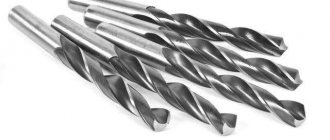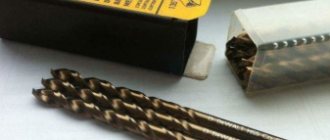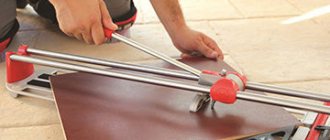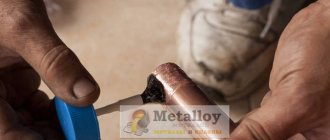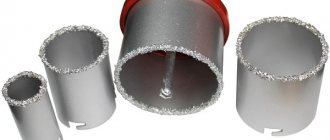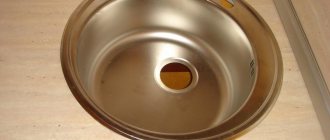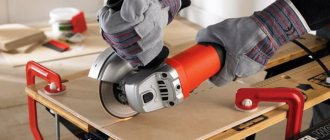When renovations in an apartment are nearing completion, it’s nice to look at the work done. New tiles in the bathroom or kitchen sparkle on the walls, but often there is a need to make a hole in the tile to hang a mirror or towel rack or other accessories.
Drilling ceramic tiles in the bathroom
Not everyone knows how and with what to drill ceramic tiles so as not to damage their integrity. It is extremely easy to spoil fragile ceramics; to avoid this, you need to know how to work with it.
Basic principles of drilling ceramic tiles
When working with ceramic tiles, it is very important to take into account its parameters (thickness, length). The drilling process must be treated with extreme care and precision. Important factors to take into account include:
- overheating of the tile and drill is not allowed, as this may cause the ceramic to split;
- it is necessary to cool the working surface by regularly spraying with water;
- the pressure on the mechanism should be chosen optimally, not too strong, but not too low. In the first case, the tile will probably break, in the other, it will not be possible to drill a hole;
- When drilling holes in tiles, reverse mode is unacceptable. The rotation of the drill should be leisurely and strictly in a clockwise direction;
- If a hole is made in a seam, care must be taken. There is no protective layer at the edge of the ceramic tile, so the center of the hole must be located strictly in the middle of the seam.
It is important to drill the tiles correctly so that they do not crack.
Which drill bits are best for drilling tiles?
How accurately the hole will be drilled and whether part of the tile will need to be replaced depends on the choice of drill. Before you start drilling material, you should pay attention to the following points:
- The top layer of tile is quite slippery. To prevent the drill from slipping, it must be held in a certain position. Sticking a piece of masking tape to the drilling site will help eliminate excessive slipperiness;
- In order to drill a hole in a tile, you need to select the appropriate drill bit. Drills for brick or concrete are not suitable in this case; the tiles will split and eventually crack.
To prevent the tiles from cracking, you should choose the right drill. The following types are suitable for drilling tiles:
- A diamond-coated drill will drill through tiles with the best quality. It has a high price. It is not economically profitable to buy an expensive tool for several holes. Diamond-coated tips are purchased mainly by those whose work is related to interior decoration;
- a drill with a pobedit tip is not inferior to diamond coating, but differs significantly in price and is more accessible to a wide range of consumers. A common type of drill, available for sale at any home improvement store. The result of using a drill with a Pobedit tip is quite neat holes, including in tiles;
- special drills, the cheapest for working with various types of surfaces and materials, including ceramic tiles. However, there is a risk of damaging the coating when performing work with such a tip.
The best option for everyday use is a drill with a Pobedit tip.
Choosing a tool
Ceramic tile coating has been described as a reliable and moisture-resistant material. It is used for walls and floors in the bathroom and kitchen. The tiles perfectly protect walls from moisture.
An example of finishing a bathroom with ceramic tiles
Thanks to the color palette, it is easy to choose tiles to suit any apartment design.
Bathroom decoration with beige ceramic tiles
Since the hardness of ceramic tiles varies, drilling can be done with different tools:
- a hammer drill with a “no impact” drilling mode;
- hand drill;
- electric drill;
- corded or cordless screwdriver.
A hammer drill is used very often in repairs. Its main purpose is to drill holes in a variety of materials.
Hammer
Hammer diagram
Before you start drilling ceramic tiles, you need to determine the work procedure.
- Usually, on the front side of the tool there is a mark with a picture of a drill. It is necessary to turn the toggle switch to this position.
- When performing work, it is forbidden to press the hammer drill trigger with force. There should be no extraneous hum, shaking, or knocking.
hammer drill
How to insert a drill into a hammer drill
A hand drill is a mechanism of the simplest design, consisting of a frame and a chuck. To make holes in the tile, a drill is inserted into the chuck, and the device begins to work. It operates slowly, and you need to strain to make a hole. The advantage of the device is its independence from electricity. A hand drill is most often used to make small holes.
Hand drill (brace)
Electric drill - cope with the task in a few seconds. Operates from a 220 W network. The tool drills holes in ceramic tiles at low speeds using a light feed. The work area should be periodically cooled with water.
Electric drill
How to choose a drill
Screwdriver - There are two types. In order to make holes in the tiles, it is necessary to use a screwdriver (preferably cordless) at a speed not exceeding 900 rpm. A mains-powered device must also have a low-speed operating mode.
Screwdriver
screwdriver
Drilling with a crown and ballerina
If you need to efficiently and accurately cut a circle of any diameter, professional tools for drilling tiles will come to the rescue. These include diamond-coated crowns and ballerinas with Pobedit incisors.
It is easier to work with a diamond bit, since it is a cylinder of a certain diameter with a cutting diamond edge. To center the crown, a conventional Pobedit drill is located in the center of the cylinder.
The ballerina is a regular drill, which has one or two L-shaped pins with a cutter at the end. The pins are secured using a clamp. By extending the pin, the desired diameter is set. This is the advantage of the nozzle over diamond crowns, which have a fixed diameter.
Ballerina
Despite the fact that this tool is the simplest and most accessible, working with it requires some skill:
- Models with one cutter are more durable, but during operation such a ballerina becomes an eccentric, which leads to vibration.
- Models with two cutters are less durable; it is difficult to set both cutters to the same radius. Because of this, the tool cuts two circles, making a double cut.
- When working, it is necessary to maintain a right angle between the axis of the drill and the surface of the tile, otherwise the ballerina will begin to bury itself on one side of the circle. To ensure that this angle is maintained constantly, ballerinas are produced with a plastic basket. It functions as a control stop and can help the master maintain the angle.
When working as a ballerina, double-sided drilling is performed. First, a protruding drill bit makes a hole in the ceramic tile. As the drill goes deeper, the cutter begins to cut the glaze. Having cut through the glaze, continue drilling from the back side.
Crown
Crowns are sold in sets of standard sizes. Before working with a crown, you first need to drill a central hole with a regular drill into which the crown drill is inserted.
Video of using the crown:
Modern plumbing fixtures are equipped with decorative facing washers on the pipe, and sockets have linings that can cover a hole cut by hand or with a grinder. Therefore, it is not always necessary to cut an even circle; sometimes you can do without special tools.
Drilling large diameter holes
When drilling holes for water pipes, a socket or a switch, where the diameter is more than 20 mm, use a ballerina or crowns.
Examples of unsuccessful drilling of tiles for electrical outlets
A crown is a tubular type instrument with a special (diamond) coating. The fairly high price of the cutter is offset by time savings and drilling quality. Using diamond core bits, it is possible to make holes with a diameter of up to 160 mm.
Drilling with cooling
Ballerina is a drill with a sharp tip, similar to a spear, on the lower part of which a holder is attached. Another drill of the same type is attached to it. By moving the bracket, you can set the diameter of the intended hole.
Drilling with a crown
Securing the crown
The drilling technique is similar to drilling for a dowel. The cutter is placed exactly parallel to the tile, so that when it goes deeper, the drill begins to evenly cut the ceramic around the circumference. Sideways movements are not allowed.
Drilling porcelain stoneware
Drilling with a diamond core involves the process of operating the drill at high speeds. Overheating in this case cannot be avoided; in order to avoid heating and burning of the crown, it is necessary to moisten the device with water. Of course, you can drill ceramics “dry”, but only at low speed.
If the cutter does not have diamond protection, do not use the “dry” method. Moreover, using water when drilling speeds up the process.
Drilling by ballerina
Working as a ballerina begins with setting the desired diametrical size. It is necessary to hold the tile and start drilling strictly at low speed. When working, it is recommended to use safety glasses to prevent waste particles from getting into your eyes.
Drilling with a circular ballerina drill
The drill must be held accurately, without changing position or tilting. Don’t forget to place a container of water nearby; when drilling ceramics with a ballerina, you also need it. The main thing is not to rush, act with caution so as not to damage the tiles.
The hole in the tile is cut by a ballerina
Advice! Drilling large diameters in tiles requires some skill. Therefore, it would be a good idea to practice on old tile scraps. Such training will allow you to “get your teeth into” and gain some experience, albeit a little!
How to drill tiles in the bathroom
How to drill tiles?
The final stage of preparing the walls in the shower room is tiling. It means the final finishing work of the room. Fixing ceramics in the bathroom is directly related to the need to install various shelves, cabinets and other interior items. In order to carry out the correct installation of tile products, you need to carefully prepare them for it, i.e. drill holes. However, if done poorly, the tiles may become unusable.
It will crack or chip, which is completely unacceptable. Therefore, you should carefully approach this issue, since there can be quite a lot of reasons for the appearance of incorrect holes. In addition, you need to take into account the need for communications from electrical to water pipes. This requires additional skill, because you can drill holes between the ceramic tiles, which makes the risk of damage to it minimal.
Common Mistakes
For those who decide to drill tiles for the first time, it is common to make mistakes. However, sometimes mistakes reach the point of ridiculousness - an attempt to remove the glazed surface. In addition, novice craftsmen often try to mark ceramics, or rather, a hole for drilling with a nail or glass cutter. Separately, it is worth noting the use of a file to cut the glaze where it is necessary to drill a hole.
Drilling a hole in a tile
So, to avoid simple mistakes, the best thing to do sometimes is to just think about what you need to do. Although, of course, after scraping the glazed surface it will be much easier to drill. But regarding the future, how to mask damaged areas? After all, after such treatment, the appearance of the product will be completely unusable. Therefore, it is necessary to learn reliable and effective ways to prepare the required holes.
Tool
To drill tiles you will need a drill that has long proven itself on the positive side. It allows you to drill neat holes in the places where it is required, and not where it will work out. For this work you will need a hand drill, which is suitable for a diameter of no more than 12 mm. An electric tool operating at minimum speed, as well as a cordless or conventional screwdriver. Choosing a drill will be more difficult, since simple ones will not be suitable for wood or concrete.
Tile drills
- Diamond sputtering. A drill with this tip is the most effective option for drilling holes. It is convenient to use in work, however, its weakness is its high cost. Often these models are purchased by specialists involved in repairs on a professional basis. Purchasing an expensive element for several holes is a dubious pleasure.
Diamond Coated Drill
- Pobedite tip. According to the recommendations of home craftsmen, this drill is considered the most suitable option for drilling around the house. This copy is an order of magnitude cheaper than the diamond one, but at the same time copes well with tiles.
Drill with pobedite tip
- Specialized. This type of drill also copes well with the task. Its productivity will last for many years, while it is cheaper than models made from diamond, but more expensive than analogs made from pobedit.
Special drill bit for drilling tiles
Useful tips
In order to be able to drill ceramic tiles, you need to get some practice. Based on it, while making a sufficient number of mistakes, you can gain some experience. However, often there is not the required amount of material, as well as time, but you want to do the job correctly. To do this, you should study the recommendations from professionals in their field:
- The location of drilling a hole on a tile product must be marked at least 15 mm from the edge of the edge, otherwise the tile may break.
- To drill a hole without problems, you need to soften the drill from sliding off the surface of the tile. Masking tape is often used for this. It is glued to the work surface, after which they begin to drill through the tape.
To reduce the risk of cracks, ceramic tiles should be left in warm water for 30 minutes. During the drilling process, wet the area where you plan to make the hole.
Proper drilling of holes in tiles
Large diameter holes
You can drill holes significantly larger than the average parameters using a diamond-coated crown or a special circular nozzle for ceramics. To do this, you need to mark the place where you need to drill, and then install a drill with a crown of a suitable diameter, after which drilling is carried out from the front side. When using a reliable crown, an experienced specialist will complete the job in a few minutes.
Crown for drilling larger diameter holes in tiles
If you need to drill a hole of non-standard sizes, then a circular drill or a ballerina drill is suitable for this. The drill is selected to match the dimensions of the hole, after which the entire procedure is carried out. The entire process should take place at low speed, so it is best to hold the tile firmly with your hands and also use safety glasses.
Special attention should be paid to constantly maintaining the drill perpendicular to the tile and preventing the tool from becoming loose during work. A regular drill tripod will do the job perfectly.
In order to perform drilling yourself, it is best to practice on already damaged workpieces. This, of course, will not make you a professional, but it will give you some experience.
Video instruction
Bathroom renovation: how to drill tiles
Ceramic tiles are an excellent finishing material for rooms with high levels of humidity. Due to their hygienic properties and ease of use, ceramic tiles are ideal for the bathroom. It is very easy to wash and looks stylish. It protects well from moisture and is not susceptible to mold. In addition, this material is considered fireproof and very reliable.
But at the same time, when planning to make a wall cabinet or a mirror in the bathroom, you may encounter difficulties. Ceramics is a hard, but at the same time fragile material. Therefore, it is important to know how to drill tiles so as not to damage them. If handled carelessly, it can become cracked and break.
There are several rules on how to work with tiles and ceramic tiles. Holes should be made further from the edges, use a professional power tool. When drilling ceramic tiles, do not allow them to overheat.
When choosing tools to decide how to drill tiles, choose a drill with the ability to control the rotation of the drill. A tool with a high rotation speed may damage the tiles or break them into pieces. An electric drill is best suited, by controlling it you can smoothly change the rotation speed. If you don't have an electric one, you can use a hand drill. Initially, holes are made in the tiles and then attached to the designated place. Before drilling tiles, you need to select special drills. They must have soldering tips made of a special hard alloy. In accordance with the size of the intended holes, you need to select the required sizes and drill bits. They are used at the last stage of drilling. If you plan to make several holes, use a level.
Using a marker or felt-tip pen, you need to mark the tile where the hole should be. To do this, you need to make a small indentation using a hammer, the smallest drill or a metal tap. When considering ways to drill tiles, it is necessary, first of all, not to forget about caution when working with fragile material. The speed of the drill must be adjusted without pressure, very smoothly. If you have an impact drill, then initially you need to use the non-impact mode. After passing the hardest, upper part of the tile, you can switch to impact mode. As a tool for drilling, you can use not only a drill, but also a hammer drill. When working with it, you need to select a drill with a larger diameter than the Pobedit one. This will protect the tiles from splitting during the use of the impact mechanism.
These tips apply to drilling tiles that are in a horizontal position on the floor. But sometimes the question arises about how to drill tiles if they are already attached to the wall. Initially, the tile must be tapped so that there is no void underneath, otherwise it may collapse during drilling. To avoid deformation of the tile surface, you need to attach a paper rectangle to the place where the hole was supposed to be made. You can use masking tape for this purpose. Such measures are also necessary to ensure that the drill does not slip. To judge a drill, it must be lowered into water.
A master who drills tiles at home must be able to handle the tool and have experience working with it. If you are confident in your own abilities and are not afraid to harm the facing material, then feel free to start the repair.
Top 10 Broke Stars It turns out that sometimes even the biggest fame ends in failure, as is the case with these celebrities.
15 Cancer Symptoms Women Most Often Ignore Many signs of cancer are similar to symptoms of other diseases or conditions, which is why they are often ignored. Pay attention to your body. If you notice.
7 Body Parts You Shouldn't Touch with Your Hands Think of your body as a temple: you can use it, but there are some sacred places that you shouldn't touch with your hands. Research showing.
10 charming celebrity children who look completely different today Time flies, and one day little celebrities become adults who are no longer recognizable. Pretty boys and girls turn into...
Our ancestors slept differently than we do. What are we doing wrong? It’s hard to believe, but scientists and many historians are inclined to believe that modern man sleeps completely differently than his ancient ancestors. Initially.
What is it like to be a virgin at 30? I wonder what it’s like for women who didn’t have sex until almost middle age.
How to drill tiles correctly: choose a drill according to tiles and tiles
Ceramic tiles are a universal finish for walls and floors that have a number of advantages. It is widely used in rooms with high levels of humidity and pollution. In residential buildings, it is almost always used in the bathroom and kitchen (at least in the work area). This is due to its moisture resistance, ease of maintenance and the ability to wash its surface even with chemicals. In addition, it is durable and very strong, can withstand heavy and prolonged loads without losing its original appearance.
When finishing walls with tiles, one way or another, it becomes necessary to drill holes in it to connect communications (pipes, electrical outlets) or to attach shelves, cabinets, lamps, heated towel rails, hooks, etc. to the walls. This is where the problem arises, because the tile itself is quite fragile, so you need to drill it carefully and only with special drills, otherwise you will have to spend money on repurchasing broken tiles or locally change the finish in places where it is damaged. We will talk further about how to drill tiles correctly, with which drill and how to drill them.
How to drill tiles correctly
To drill tiles, you can use an electric or hand drill, cordless or corded screwdriver. The minimum rotation speed is selected - up to 1000 revolutions, and the tool itself is selected depending on the desired hole diameter.
How to drill into tiles without cracking them? There are several universal secrets that professionals use:
- drill a hole at a distance of more than 15 mm from the edge, which will reduce the risk of cracks and chips; the closer to the edge, the higher the likelihood of damage;
- Before drilling, put the tiles in water for half an hour to an hour. By absorbing moisture, ceramics become less fragile;
- if the tiles are already installed, you can wet the drilling site with water during the working process;
- when the hole is located in the seam, the risk of their splitting is minimal, but the dimensions of the hole should not extend beyond the seam and affect the tiles. This method, although simple, is rarely used, because the width of the seam is small and it is not always possible to place fasteners exactly between the tiles;
- the rotation speed of the electric drill should not exceed 1000 rpm;
- the surface of the tile should not get very hot, so during the drilling process it must be cooled by wetting it with water, otherwise cracks may appear;
- The drill should not be pressed hard against the tile - this can lead to its destruction. You need to press the tool carefully so that the drill can move inward, but nothing more;
- when drilling mounted tiles, first use a special drill (diamond, pobedite or special), and then use a drill for concrete or brick to make a hole in the wall itself;
- a special drill for tiles and tiles is selected with a slightly larger diameter and is used only for drilling tiles. A drill for concrete or brick should be slightly smaller (a couple of millimeters) in order to freely pass through the resulting hole in the tile.
Depending on the size of the holes and their purpose, the drilling process and the tools used for this may vary.
Drilling holes in tiles for dowels
The surface of ceramic tiles is hard and smooth, so the tool glides over it when drilling. To securely fix it in the desired position, you need to glue masking tape to the location of the future hole, and then drill through it.
Another important point mentioned above: holes in the tiles cannot be made with a regular drill, which is used for concrete or brick. When using it, the tile will almost certainly crack, so the result directly depends on the correct choice of tool. In this case, you need to use a tile drill, which can be:
- with diamond coating;
- with a pobedite tip;
- special for tiles.
A diamond-coated drill is expensive, although it is the most suitable option. Diamond is much stronger than the top layer of tile, so it drills through it quickly and without much effort. But there is no point in buying such a drill for two or three holes, so if possible, it is better to rent it from professional builders.
Diamond Coated Drill
A drill with a pobedit tip is more affordable, which is why it is used more often among non-professionals. You can buy it at the bazaar or at a building materials store.
Pobedite drill bit, for drilling walls
Special drills are used exclusively for drilling ceramic tiles and glass. They may come in handy in everyday life, and more than once, so it is better to purchase them just in case, especially if you have the financial opportunity.
Once the drill is selected, it's time to get straight to work. Drilling holes in ceramic tiles consists of the following steps:
- masking tape is glued to the location chosen for the hole;
- the exact drilling location is marked with a dot or cross;
- a tile drill is installed in the tool;
- a hole is drilled in the tile;
- The “tile” drill is replaced with a “concrete” drill;
- a hole of smaller diameter and the required depth is drilled in the wall. To determine the depth, a mark is applied to the drill in advance, upon reaching which drilling stops;
- the drill is removed;
- the resulting hole is blown out and cleared of dust;
- A dowel is inserted into the hole, going a couple of millimeters into the tile.
This algorithm is designed to produce holes whose diameter does not exceed 15 mm. But often this is not enough, for example, for installing sockets or laying pipes.
Drilling tiles for laying communications
To obtain larger holes, you need to use a more serious tool: a hammer drill, a drill or a ballerina.
To drill a hole in tiles with a hammer drill, you can use an expensive but effective diamond core bit. Its cost is quite high, so it is often replaced with a cheaper crown with pobedit teeth. This is a less durable analogue, which is enough for a maximum of 30 holes, which is quite enough for one apartment or house. Drilling sequence:
- the tiles are laid on a flat surface, preferably wooden, so that it is not hard;
- Markings are applied to the front side along which drilling will be carried out;
- A hole is cut using a puncher according to the markings.
Using a hammer drill to make large holes is the fastest, most affordable and safest way.
Drill for ceramic tiles
When drilling with a drill, a diamond bit is also used, which makes this method expensive. The sequence is similar to that described above. With a high-quality crown, the hole will be ready in 5 minutes maximum.
If you don't have a diamond bit for your drill, you can replace it with a diamond tip. In this case, the process becomes more complicated and consists of the following steps:
- The outline of the future hole is applied to the tile: a circle for a pipe or a rectangle for a socket. You can use a compass, a ruler, or simply attach and circle the desired object;
- Holes are drilled along the contour, the edges of which slightly protrude beyond the outlined boundaries (by a couple of millimeters). The result is about 20 holes, the diameter of which is 4-6 mm;
- the middle of the contour is carefully knocked out;
- the nicks remaining along the edges are broken off with pliers, after which the inner surface is sanded and cleaned.
This method of making holes is highly complex, takes a lot of time and requires not only nerves of steel and a steady hand, but also certain skills in working with the tool.
To drill the laid tiles, use a drill with a tungsten bit. In this case, to fix the drill in the desired position, a template with a marked outline of the future hole is used. It is applied to the wall, and a hole is drilled through it with a drill.
Drilling holes in tiles with your own hands
When you need to make a hole of a non-standard shape and size, a circular drill or, as it is also called, a “ballerina”, is used. To do this you need:
- determine the diameter of the hole. For a hole with a diameter of 5 cm, there should be 2.5 cm between the drilling points;
- mark the drilling locations;
- drill holes. In this case, the tool should operate at a minimum speed of up to 1000 rpm and not swing from side to side. A special tripod is used to fix it. The tile itself must also be securely fixed in a given position. During the process, small fragments may fly out from under the drill, so personal protective equipment, including safety glasses and gloves, must be used.
Drilling tiles seems difficult only at first glance, but in fact there is nothing difficult about it if you strictly follow the advice of professionals and use the right tools. Indeed, there is a risk of damage to the tiles, which can lead to overpayment for materials or even repeated repairs if the tiles have already been laid, but if everything is done correctly, troubles can be avoided. It is important to pay attention to what and how to drill ceramic tiles - often it is an incorrectly selected tool that causes damage.
Diamond-coated drill Pobedit drill for drilling walls Drill for glass and tiles Diamond-coated bit for tiles Drill used for drilling tiles Drilling a hole in a tile with your own hands Drilling holes using a ballerina tile drill Drilling holes in a tile DIY tiles
- How to drill tiles on a wall How to drill tiles on a wall It’s impossible to do without holes in the tiles - you need to fix...
- How to plaster walls under tiles in a bathroom How to plaster walls under tiles in a bathroom? What mixtures are best to use for plastering walls in...
- What drill to use to drill tiles in the bathroom How to drill tiles without cracking: video, photos, tips The answer to the question of…
- Leveling the walls in the bathroom under tiles Assessing the need to level the walls The traditional method is leveling with plaster Alternative methods Tips The best finishing material…
How else can you drill into tiles?
There is another technique that can be used to make a large hole in a tile that is not yet glued to the wall. To do this, as mentioned earlier, the ceramics are immersed in a basin of water. After a while, take it out and wipe it. Mark the diameter of the desired circle on the tile (draw a circle). Holes are drilled around the perimeter so that the center of the circle can be broken off. Therefore, the holes must be drilled close to each other. The resulting hole in the tile is ready, you can insert it into the pipe. The edges turn out uneven, we process them with a file.
The order of drilling small holes around the circumference
Gently knock out the center with a hammer
File uneven edges
The method is applicable if you don’t have a ballerina or a cutter at hand.
Advantages:
- The tile can be prepared in advance for the hole drilling process.
- soaked tiles significantly reduce the risk of splitting.
General rules, useful tips
After choosing a tool, you need to figure out how to drill the tiles so that they don’t crack. There are several general rules:
- First pass. Performed on a prototype. This makes it possible to understand the principle of operation of the nozzle and the features of its behavior.
- Marking. Marked with a pencil or marker. For convenience, so that the mark does not fly off, masking tape is glued to the tile. It is more convenient to mark the drilling point; the marker will not be erased and the mark will not move.
- Adjusting the speed of a drill or screwdriver. Tile/ceramic edges are drilled at a speed of 100-400 rpm. This is enough to go through the durable top layer without damaging the tile.
- Substrate. If you are drilling into tiles that have not yet been laid, the underlying surface must be level. If you do not follow the rule, then when you press on the tile, it may burst.
- Drilling time. The tool head becomes very hot. Therefore, the work speed is low, without strong pressure on the drill. As a last resort, the working area is wetted with water.
Video instruction
Little tricks for drilling tiles
Like any business, drilling has its own tricks and secrets, knowledge of which will help make the task easier and get the job done efficiently:
- You should not make holes close to the edge of the tile, this can cause it to split;
- if special drills are not available, you can use ordinary ones for metal. In this case, you can drill only at low speeds;
- if the drilled hole for the dowel has a large radius, you can insert an ordinary wooden chopper into it;
- To reduce contamination from drilling, you need to place a scoop directly under the work area. For installation of a screen under a bathtub, read the link.
Using a hacksaw and string to cut tiles
Using a tile glass cutter and pliers for making a hole in a tile

